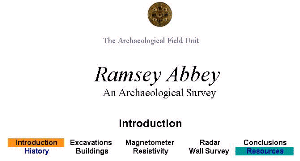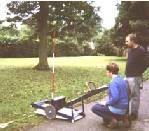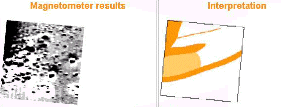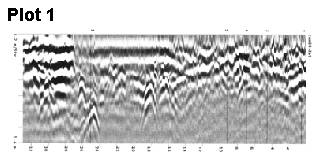
Figure 1: The CD is broken down into ten subject areas
Cite this as: Gaffney, C. 2002 Review of Ramsey Abbey - An Archaeological Survey, Internet Archaeology 13. https://doi.org/10.11141/ia.13.6
Ramsey Abbey - An Archaeological Survey. A CD-Rom for PC and Mac by Paul Spoerry and Spencer Cooper. Acrobat plugin required (supplied with CD). Purchase details available from Field Archaeology Unit, Cambridgeshire County Council. Email: arch.field.unit@cambridgeshire.gov.uk.
The CD is designed to be read using most standard web browsers and is compatible with both Windows and Mac operating systems. Occasionally in order to view a diagram you are transported into Adobe Acrobat, a copy of which is on the CD.
The CD is the culmination of a community based project based on the medieval abbey at Ramsey in Cambridgeshire, England. According to the sleeve of the CD the project was paid for by a Royal Society and British Association Millennium Award, which was funded by the Millennium Commission to 'encourage people's understanding of science, engineering and technology in the community'. The science in question largely involves the small-scale, perhaps even surgical, use of resistance, magnetic and ground penetrating radar (GPR). The project, however, had a more interesting agenda, one that involves the testing of an archaeological problem.
In short, the Archaeological Field Unit (AFU) of Cambridgeshire County Council found that there were competing hypotheses concerning the location of the former church on the now-ruined abbey site. The CD pieces together the evidence for the church, collected with the help of the children at the school that now occupies the site. The CD can be seen as part of the remit to reach the wider community that also involved open days, seminars and a web site.

Figure 1: The CD is broken down into ten subject areas
On starting the CD the viewer is offered ten subject areas (See Figure 1). In general the headings are straightforward and you get the sort of information that you would reasonably expect. However, I found that some of the layout was rather eccentric with pages being laid out differently. Furthermore, the subject areas feel very unbalanced - some are wordy, some are minimalist in the extreme. The History area contains no images and while that may not be a crime I can see many non-specialists (especially children for whom this must be a target audience) skimming through it.

Figure 2: Lining up
for a GPR traverse
Overall there is a feeling that the authors made use of what they had available rather than preparing material specifically for the CD. This is particularly true in regard to the quality of some scanned images that should have been enhanced.
What of the science? This is treated in a generalist manner, as might be expected when considering the wide audience base that the CD is aimed at. I would again say that the style of delivery is relatively dense, although there are many valid points made in the text. There are many useful snippets, such as reiterating the need for comparative data. Also the authors make a number of important points regarding the theory of resistance survey but undermine their argument by the use of an unreadable diagram. Although the diagram is referenced to Clark 1990, presumably 'Seeing Beneath the Soil', I couldn't find the full reference on the CD. The text as a whole is rather short on references and one presumes that the authors have regarded the publication as a stand-alone volume.

Figure 3: Typical magnetic output from Ramsey Abbey
It is in terms of the data presentation that I am most concerned. On the greyscale plots there are no vertical scales. I would not necessarily expect detailed information in a publication for 'Joe Public', but even 's/he' needs to know if black is high or low, positive or negative. This publication is hardly the first to miss out information on signal strength (see the diagram on the first page of English Heritage's 'guidelines' (1995) for one example), but I for one would like it to be the last. Similarly, the interpretations would have been better if they had a key or numbers for cross-referencing with the text.

Figure 4: An example of the small-scale resistivity (resistance?) survey used in this project
The conclusions of the project are rewarding in that the evidence has suggested that while one of the models for the abbey can be refuted, the other has to be refined. Although that may sound a bit vague, that is how archaeology often works and it is worthwhile to point this out to the general reader. The exercise also illustrates that having a black box and a white lab coat will not give you the perfect answer every time but, given a strong research design, you should get closer to a suitable explanation.

Figure 5: Data output from one of the GPR traverses
The majority of the work was undertaken in 1999 and the CD produced in 2000. The work is already three years old and some areas of prospecting have come a long way in that time. In particular the concept of 'time slicing' for the GPR, although reasonably novel in 1999 is fairly standard today (Nishimura and Goodman 2000).
It is probably best to consider this CD as a cheap alternative to a printed book. However, as a delivery format it is difficult to see the benefits of this CD over a traditional printed book - there is no added value in terms of external links or 'hands-on' data processing. Perhaps it is possible to dismiss these points, as the CD is probably going to achieve most with children and young adults who are likely to be turned on to the media rather than the message.
English Heritage 1995 Geophysical Survey in Archaeological Field Evaluation. Research and Professional Services Guideline No. 1.
Nishimura Y. and Goodman D. 2000 'Ground Penetrating Radar Survey at Wroxeter'. Archaeological Prospection 7(2), 101-5.
Clark A. 1990 Seeing Beneath the Soil: prospecting methods in Archaeology. Batsford, London.
* Chris Gaffney
GSB Prospection
Cowburn Farm
Market Street
Thornton
Bradford BD13 3HW
Email: gsbprospection@btconnect.com